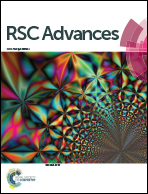Half-cell and full-cell applications of horizontally aligned reduced oxide graphene/V2O5 sheets as cathodes for high stability lithium-ion batteries
Abstract
2D hybrid sheets of V2O5 and reduced graphene oxide (rGO/V2O5) have been synthesized using a hydrothermal method. With the addition of tiny amount of rGO content (6.25%), the proper conductivity and accessibility of hybrid nanosheets for lithium ion migration are obviously promoted. Compared with the bare V2O5 sheets, the rGO/V2O5 hybrid sheets exhibited enhanced electrochemical performance in terms of improved cycling stability (nearly 81.5% capacity retention after 200 cycles), high reversible capacity of 249 mA h g−1 at a current density of 100 mA g−1 and good rate capability for the half cell. Significantly, a Li-metal-free full battery is assembled successfully, with rGO/V2O5 hybrid sheets and lithiated graphite for cathodes and anodes, respectively. This full Li-ion battery exhibits a superior specific capacity of 213 mA h g−1 at a current density of 100 mA g−1 and a high specific energy density of 106.5 W h kg−1 as a result. The good electrochemical performance suggests that this unique 2D hybrid material could be a promising candidate as a cathode material for lithium-ion batteries in the near future.


 Please wait while we load your content...
Please wait while we load your content...